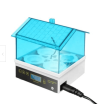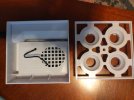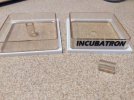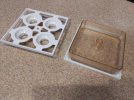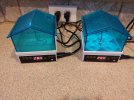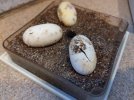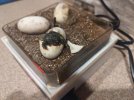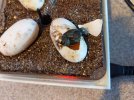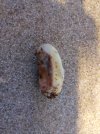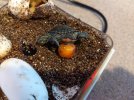SeverusBites
Member
Hello Folks,
I wanted to share this turtle adventure. A decade ago I saw a box turtle lay eggs in my yard, retrieved them, and hatched 4 of 4 baby 3-toed box turtles, an amazing experience. A few years back I found an RES laying, and later dug up 14 eggs which all hatched, and after a year for most, two years for some, I repatriated them to their ancestral pond. This was another cool and fun experience, so the other day when I came across a Western Painted laying, I decided to try again. To be clear, both of these nests were essentially adjacent to heavily traveled footpaths in my neighborhood, so the chances are the eggs and hatchlings have a better shot with me.
My wife and I were walking around the neighborhood pond when we saw this:
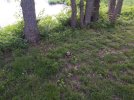
I felt bad for the poor girl, the "soil" here is a gluey clay mud filled with rocks that is so sticky that it is difficult to dig in or even remove from your tools or hands.
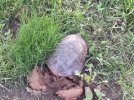
Anyway, I left her alone and came back the next day. A convenient stone helped mark the spot, but the awful mud didn't allow much concealment so the nest was quite apparent.
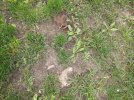
The RES nest was in dryer earth and was essentially invisible when I looked for it, it took some poking around to find the spot, but this nest was right where I thought it was.
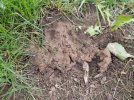
This clay is so hard to spread that the nest just had a smear of clay across the top as a cap, I could practically lift it off as one piece. You can clearly see the disturbed vs. non-disturbed earth here.
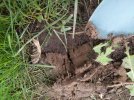
In the first go-round with the RES, I dug up 14 eggs but destroyed a 15th while digging. I was determined to avoid that calamity this time, so I carefully excavated the nest. There was a big root right across, more tribulation for her. . . I cut it out with my pocketknife, and the blade is pointing right at the plugged tube that descends into the nest chamber.
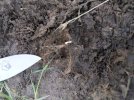
Continuing on, I removed the plug material, and soon I could see an egg. . . I was worried that since I'd disturbed her she might have moved elsewhere or that this might be a decoy nest, but no- eggs for sure.
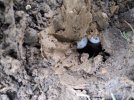
The soil is so gluey that the chamber didn't fill in at all with loose dirt. It was a totally open chamber under the plug of clay.
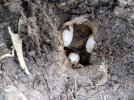
After carefully getting the eggs out, you can see the rather large size of the chamber. Indeed, there was a big rock in the center, so she dug a donut of space around the rock and deposited the eggs there. I can't help but think that if I was 1" tall, it would have been cool to spelunk in there and see the huge eggs. . .

Anyway, I found 4 eggs in the nest, all looked great. One was laid more vertically, I kept it in position as I've been taught. One other egg rolled over while I was picking it up, Hopefully it survives. I know they need to stay right-side up, but I'm not sure how much and instant of gentle movement would matter.

I took them home and set up my tried-and-true incubator, this setup has hatched 18 of 18 eggs so far, with 4 more in the oven. It's just a cooler with some water and an aquarium heater.
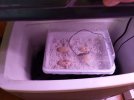
The temp has stabilized at 81f and I think that will be fine. These, if they hatch, will come out around the end of July or a bit later.
At that point, I will release any other pond turtles I have and devote the space to these guys. I so love to watch little turtles grow up! Then, after overwintering with me, they will have quite a head-start, and I'll release them back into the ancestral pond, and with luck, begin the cycle again. . .
With luck I'll be back in about 70 days with a new post and some new baby turtles. . .
Thanks for looking.
I wanted to share this turtle adventure. A decade ago I saw a box turtle lay eggs in my yard, retrieved them, and hatched 4 of 4 baby 3-toed box turtles, an amazing experience. A few years back I found an RES laying, and later dug up 14 eggs which all hatched, and after a year for most, two years for some, I repatriated them to their ancestral pond. This was another cool and fun experience, so the other day when I came across a Western Painted laying, I decided to try again. To be clear, both of these nests were essentially adjacent to heavily traveled footpaths in my neighborhood, so the chances are the eggs and hatchlings have a better shot with me.
My wife and I were walking around the neighborhood pond when we saw this:

I felt bad for the poor girl, the "soil" here is a gluey clay mud filled with rocks that is so sticky that it is difficult to dig in or even remove from your tools or hands.

Anyway, I left her alone and came back the next day. A convenient stone helped mark the spot, but the awful mud didn't allow much concealment so the nest was quite apparent.

The RES nest was in dryer earth and was essentially invisible when I looked for it, it took some poking around to find the spot, but this nest was right where I thought it was.

This clay is so hard to spread that the nest just had a smear of clay across the top as a cap, I could practically lift it off as one piece. You can clearly see the disturbed vs. non-disturbed earth here.

In the first go-round with the RES, I dug up 14 eggs but destroyed a 15th while digging. I was determined to avoid that calamity this time, so I carefully excavated the nest. There was a big root right across, more tribulation for her. . . I cut it out with my pocketknife, and the blade is pointing right at the plugged tube that descends into the nest chamber.

Continuing on, I removed the plug material, and soon I could see an egg. . . I was worried that since I'd disturbed her she might have moved elsewhere or that this might be a decoy nest, but no- eggs for sure.

The soil is so gluey that the chamber didn't fill in at all with loose dirt. It was a totally open chamber under the plug of clay.

After carefully getting the eggs out, you can see the rather large size of the chamber. Indeed, there was a big rock in the center, so she dug a donut of space around the rock and deposited the eggs there. I can't help but think that if I was 1" tall, it would have been cool to spelunk in there and see the huge eggs. . .

Anyway, I found 4 eggs in the nest, all looked great. One was laid more vertically, I kept it in position as I've been taught. One other egg rolled over while I was picking it up, Hopefully it survives. I know they need to stay right-side up, but I'm not sure how much and instant of gentle movement would matter.

I took them home and set up my tried-and-true incubator, this setup has hatched 18 of 18 eggs so far, with 4 more in the oven. It's just a cooler with some water and an aquarium heater.

The temp has stabilized at 81f and I think that will be fine. These, if they hatch, will come out around the end of July or a bit later.
At that point, I will release any other pond turtles I have and devote the space to these guys. I so love to watch little turtles grow up! Then, after overwintering with me, they will have quite a head-start, and I'll release them back into the ancestral pond, and with luck, begin the cycle again. . .
With luck I'll be back in about 70 days with a new post and some new baby turtles. . .
Thanks for looking.
